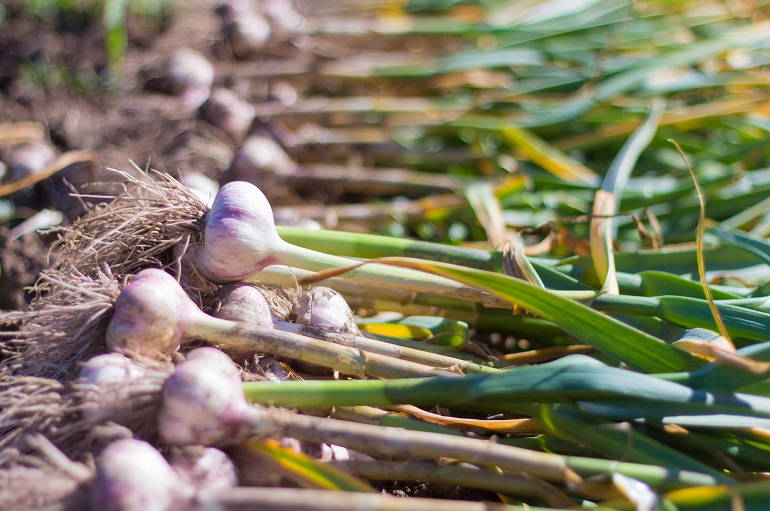Garlic Harvest Yield and Storage

This post is also available in:
This post is also available in:
![]() Deutsch (German)
Deutsch (German) ![]() हिन्दी (Hindi)
हिन्दी (Hindi) ![]() Ελληνικά (Greek)
Ελληνικά (Greek)
Garlic Yield
There is an increased demand for big cloves of garlic in the global market. To answer these needs, the growers take all necessary measures to promote cloves development. Except for selecting suitable varieties, planting distances, irrigation, and fertilization, garlic farmers that grow hard-neck garlic need to remove the scape (flower stalk) of the garlic plants before it starts to grow. If left to grow, it will suck all the nutrients from the bulb, causing it to shrink and reduce its quality. However, this technique is not necessary for soft-neck varieties.
In general, to have a satisfactory economic gain, a garlic crop should yield around 5 times more than the cloves needed for its planting. A garlic crop usually can yield between 6 and 10 tons of cloves per hectare (5,400-9,000 lb/acre), but there are references with garlic yielding 13-19 tons per hectare (11,5-17 thousand pounds per acre).
When and how to harvest garlic
The exact moment of garlic maturation may deviate based on the variety, the environmental conditions, the planting moment, etc. In general, garlic bulbs are ready to be harvested around 4 to 5 months from planting. The goal is to harvest the garlic bulbs when they have obtained the maximum size (of the variety), but the cloves remain strongly attached and protected by the bulbs’ skin. Harvesting at the right time is especially important for the hard-neck garlic varieties and can affect the product’s storage life. Usually, garlic is ready to be harvested when half of its leaves have turned yellow-brown, or the leaf tips have dried out and bent toward the ground. Among the different garlic types, Artichoke garlic matures first, while Silverskin garlic is the latest maturing type.
Garlic is harvested either by hand, with the help of digging forks, or mechanically using harvesters (potato diggers are suitable).
How to cure-dry and store garlic after harvest
Garlic is not sold or stored directly after harvesting but needs to be cured (dry out). This process can prolong the storage life and reduce the risk of infections and water loss of the garlic bulbs. Producers use several techniques for this purpose. Some traditional, small, or medium-scale growers prefer to leave the garlic on the field after harvest and take advantage of the sun’s warmth to dry them out (during summer). Other farmers transfer them to rooms with proper aeration and hang them from the ceiling. Nowadays, many garlic farmers have special drying facilities for drying their garlic under controlled temperatures and humidity levels. After the garlic has been cured, the farmers remove the tops and the roots. You are advised to leave around (1.3 cm or 0.5 inches of root and 2.5 cm or 1 inch of top).
To preserve their quality and prolong the storage life, garlic can be placed at 0-1 °C (32-34 °F) and a maximum of 60-70% RH (to avoid rotting), with good aeration and luck of light for up to 5-7 months. Garlic that will be used as ‘seeds’ for future planting should be stored at 5-10°C (40-50°F) and 65-70% RH until then. If the planting material is stored at a lower temperature, there is a high risk of rough bulbs with witches-brooming.
Usually, garlic is should as hole bulbs, and their price is defined mainly by their size and weight in 10 kg (22 lb) cartons, with around 12 tube or vexar mesh bags (2-3 bulbs each). Typically, bulbs are graded based on their diameter and classified as:
- medium (35-45mm)
- large (45-55mm)
- extra large (55-65mm)
- jumbo (65-75mm)
- super colossal (larger than 75mm)
Other important quality characteristics are the high dry weight and the content of soluble solids to be above 35%. Finally, the bulbs should be healthy, clean, well-dried, firm and white.
References
- https://www.agric.wa.gov.au/garlic/growing-garlic-western-australia?nopaging=1
- https://coststudyfiles.ucdavis.edu/uploads/cs_public/47/9d/479d7861-de24-4a60-bad8-509a3470c360/gl-ir-92-garlic-1992-processingintermountainregionshastafallrivervalley.pdf
- https://www.saskatchewan.ca/
- https://horticulture.oregonstate.edu/oregon-vegetables/garlic-1
- https://www.uky.edu/ccd/sites/www.uky.edu.ccd/files/garlic.pdf
- https://postharvest.ucdavis.edu/Commodity_Resources/Fact_Sheets/Datastores/Vegetables_English/?uid=16&ds=799
- https://www.canr.msu.edu/uploads/resources/pdfs/e3371_wcag_2.08.pdf
- http://www.omafra.gov.on.ca/english/crops/facts/09-011w.htm
- https://hort.extension.wisc.edu/articles/garlic-allium-sativum/
Further reading:
Garlic Plant information and Variety selection
General information and nutritional value of Garlic
Growing garlic in your backyard
Growing Garlic Commercially – Complete Growing Guide for Garlic from Start to Finish
Soil Requirements, Soil Preparation, and Planting of Garlic
Garlic Water Requirements and Irrigation Systems
Garlic Fertilization Requirements
Garlic Harvest Yield and Storage








































































